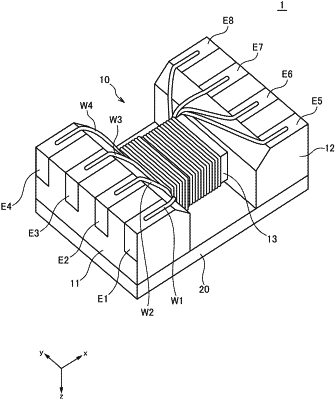| CPC H01F 27/2823 (2013.01) [H01F 27/24 (2013.01); H01F 27/292 (2013.01); H05K 1/11 (2013.01); H05K 1/181 (2013.01); H05K 2201/1003 (2013.01)] | 15 Claims |

|
1. A coil component comprising:
a core including a first flange part, a second flange part, and a winding core part positioned between the first and second flange parts;
first, second, third, and fourth terminal electrodes provided on the first flange part;
fifth, sixth, seventh, and eighth terminal electrodes provided on the second flange part;
first and second wires bifilar wound around the winding core part; and
third and fourth wires bifilar wound around the winding core part,
wherein the first, second, third, and fourth terminal electrodes are arranged in this order in a direction perpendicular to an axial direction of the winding core part,
wherein the fifth, sixth, seventh, and eighth terminal electrodes are arranged in this order in the direction perpendicular to the axial direction of the winding core part,
wherein one and other ends of the first wire are connected respectively to the first and sixth terminal electrodes,
wherein one and other ends of the second wire are connected respectively to the second and fifth terminal electrodes,
wherein one and other ends of the third wire are connected respectively to the third and eighth terminal electrodes,
wherein one and other ends of the fourth wire are connected respectively to the fourth and seventh terminal electrodes,
wherein the first and second wires cross each other in a first crossing area, and
wherein the third and fourth wires cross each other in a second crossing area different from the first crossing area.
|